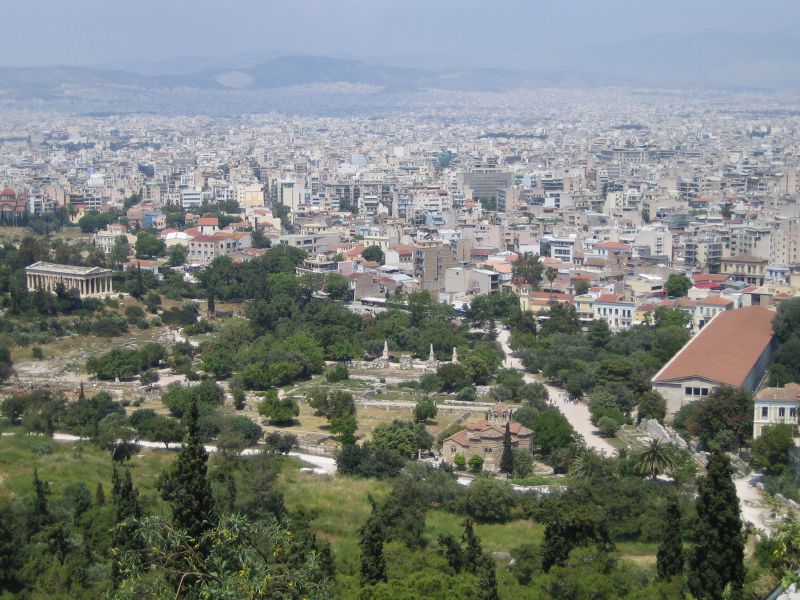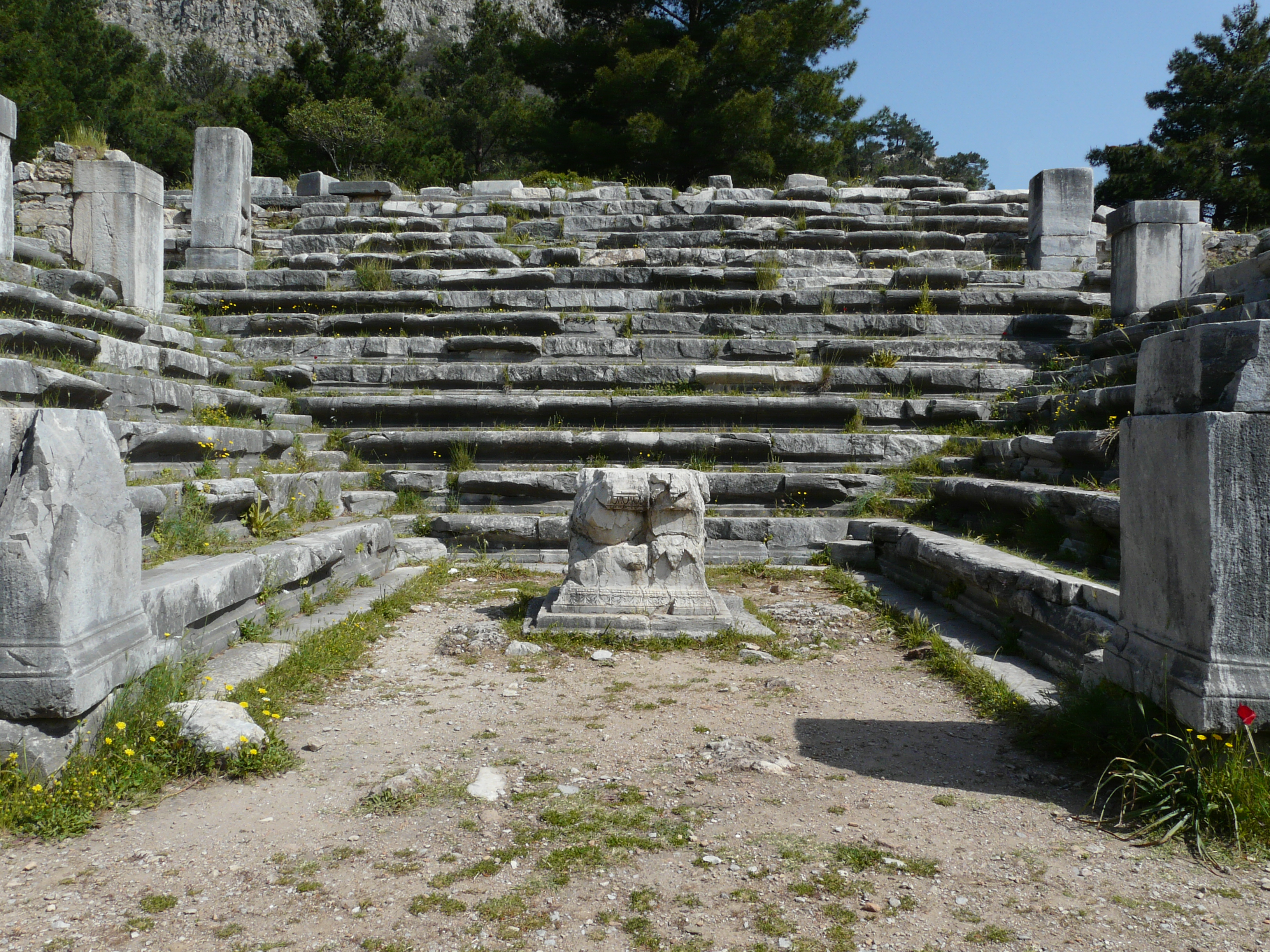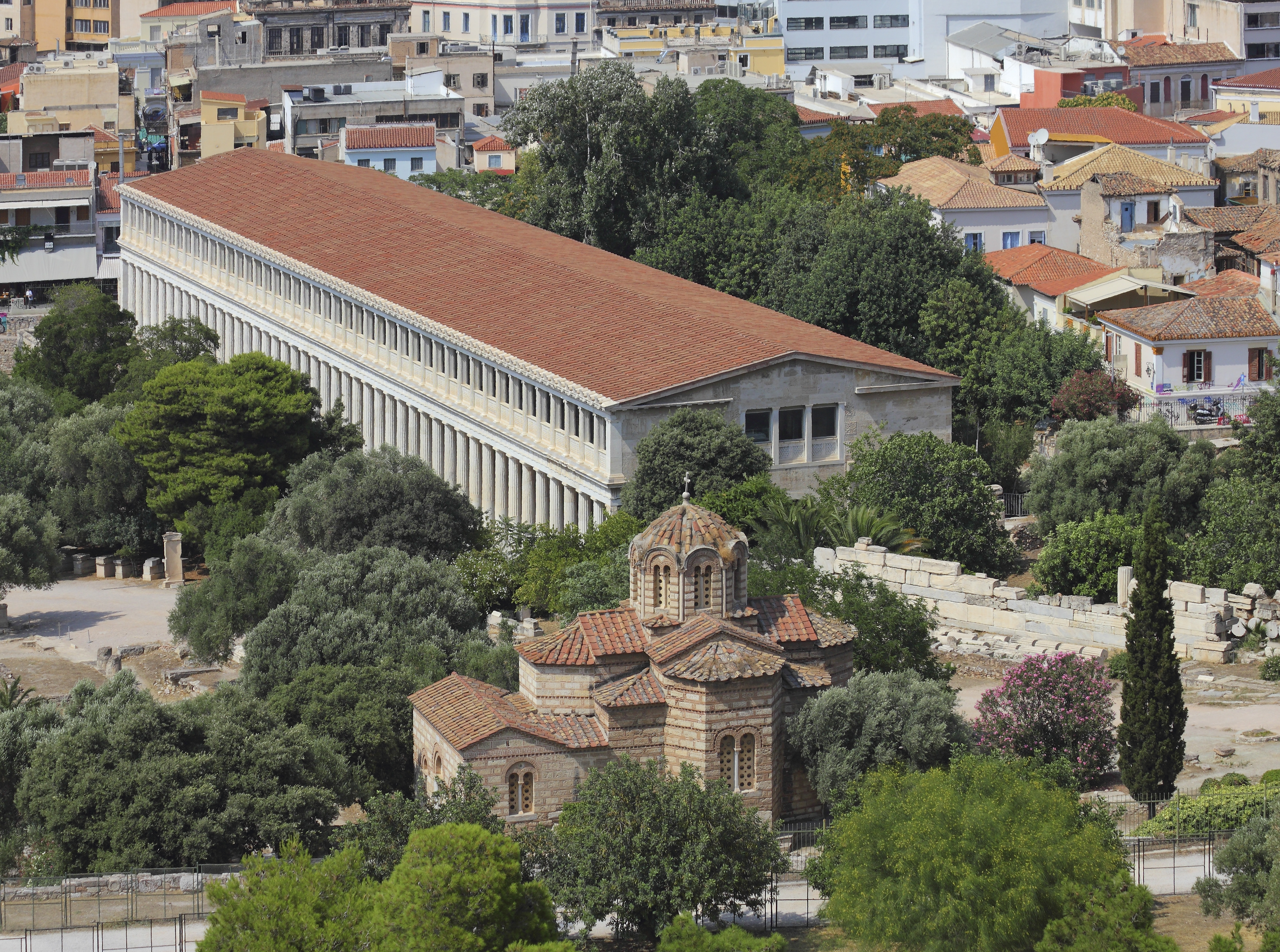|
New Bouleuterion
The New Bouleuterion is an ancient building in the city of Athens in Attica, Greece. It was located on the western side of the Ancient Athenian Agora. It is a theater with 12 rows of seats, with a seating capacity of greater than 50. A bouleuterion ( grc, βουλευτήριον, bouleutērion), sometimes translated as council house, assembly house, and senate house, was a building in ancient Greece which housed the council of citizens (βουλή, ) of a democratic city-state. Function The New Bouleuterion housed a deliberative body within the Athenian legislature known as the Boule (βουλή, boulē), or the Athenian Council. The Boule was made up of 500 members, 50 from each of the 10 tribes. Its members were chosen by lot and served a one year term. The Boule met every day except festival days to propose legislation which could then be ratified by all the citizens in the Ekklesia. History The Boule originally met in a building now known as the Old Bouleuterion, which ... [...More Info...] [...Related Items...] OR: [Wikipedia] [Google] [Baidu] |
Athens
Athens ( ; el, Αθήνα, Athína ; grc, Ἀθῆναι, Athênai (pl.) ) is both the capital and largest city of Greece. With a population close to four million, it is also the seventh largest city in the European Union. Athens dominates and is the capital of the Attica region and is one of the world's oldest cities, with its recorded history spanning over 3,400 years and its earliest human presence beginning somewhere between the 11th and 7th millennia BC. Classical Athens was a powerful city-state. It was a centre for the arts, learning and philosophy, and the home of Plato's Academy and Aristotle's Lyceum. It is widely referred to as the cradle of Western civilization and the birthplace of democracy, largely because of its cultural and political influence on the European continent—particularly Ancient Rome. In modern times, Athens is a large cosmopolitan metropolis and central to economic, financial, industrial, maritime, political and cultural life in Gre ... [...More Info...] [...Related Items...] OR: [Wikipedia] [Google] [Baidu] |
Attica
Attica ( el, Αττική, Ancient Greek ''Attikḗ'' or , or ), or the Attic Peninsula, is a historical region that encompasses the city of Athens, the capital of Greece and its countryside. It is a peninsula projecting into the Aegean Sea, bordering on Boeotia to the north and Megaris to the west. The southern tip of the peninsula, known as Laurion, was an important mining region. The history of Attica is tightly linked with that of Athens, and specifically the Golden Age of Athens during the classical period. Ancient Attica ( Athens city-state) was divided into demoi or municipalities from the reform of Cleisthenes in 508/7 BC, grouped into three zones: urban (''astu'') in the region of Athens main city and Piraeus (port of Athens), coastal (''paralia'') along the coastline and inland (''mesogeia'') in the interior. The modern administrative region of Attica is more extensive than the historical region and includes Megaris as part of the regional unit West Attica, ... [...More Info...] [...Related Items...] OR: [Wikipedia] [Google] [Baidu] |
Greece
Greece,, or , romanized: ', officially the Hellenic Republic, is a country in Southeast Europe. It is situated on the southern tip of the Balkans, and is located at the crossroads of Europe, Asia, and Africa. Greece shares land borders with Albania to the northwest, North Macedonia and Bulgaria to the north, and Turkey to the northeast. The Aegean Sea lies to the east of the Geography of Greece, mainland, the Ionian Sea to the west, and the Sea of Crete and the Mediterranean Sea to the south. Greece has the longest coastline on the Mediterranean Basin, featuring List of islands of Greece, thousands of islands. The country consists of nine Geographic regions of Greece, traditional geographic regions, and has a population of approximately 10.4 million. Athens is the nation's capital and List of cities and towns in Greece, largest city, followed by Thessaloniki and Patras. Greece is considered the cradle of Western culture, Western civilization, being the birthplace of Athenian ... [...More Info...] [...Related Items...] OR: [Wikipedia] [Google] [Baidu] |
Ancient Agora Of Athens
The ancient Agora of Athens (also called the Classical Agora) is the best-known example of an ancient Greek agora, located to the northwest of the Acropolis and bounded on the south by the hill of the Areopagus and on the west by the hill known as the Agoraios Kolonos, also called Market Hill. The Agora's initial use was for a commercial, assembly, or residential gathering place. Buildings and structures of the classical agora North side of the agora * Stoa Poikile (Painted stoa), a building built in the 4th century B.C. used purely for socialising unlike many other buildings in the agora. * Altar of the Twelve Gods * Stoa Basileios (Royal stoa) * Temple of Aphrodite Urania *The south end of what is believed to be a Basilica has been uncovered near Hadrian Street and is dated to the mid 100s CE East side of the agora * The Stoa of Attalos, a stoa lined with shops built in the 2nd century B.C. which has since been reconstructed for use as the Museum of The Ancient Agora. * ... [...More Info...] [...Related Items...] OR: [Wikipedia] [Google] [Baidu] |
Bouleuterion
A bouleuterion ( grc-gre, βουλευτήριον, ''bouleutērion''), also translated as and was a building in ancient Greece which housed the council of citizens (, ''boulē'') of a democratic city state. These representatives assembled at the bouleuterion to confer and decide about public affairs. There are several extant bouleuteria around Greece and its former colonies. It should not be confused with the Prytaneion, which housed the executive council of the assembly and often served as the boule's mess hall. Athens The Athenian Boule is better known as the Council of 500. Solon was credited with its formation in 594 BC as an assembly of 100 men each from Athens's four original tribes. At the adoption of the new constitution around 507 BC, this was changed to 50 men each from the 10 newly created tribes. (Each served a one-year term) The Old Bouleuterion was built on the west side of the Agora below the Agoraios Kolonos around 500 BC. It was almost ... [...More Info...] [...Related Items...] OR: [Wikipedia] [Google] [Baidu] |
Boule (ancient Greece)
In cities of ancient Greece, the boule ( el, βουλή, ''boulē''; plural βουλαί, ''boulai'') was a council of over 500 citizens (βουλευταί, ''bouleutai'') appointed to run daily affairs of the city. Originally a council of nobles advising a king, ''boulai'' evolved according to the constitution of the city: In oligarchies boule positions might have been hereditary, while in democracies members were typically chosen by lot and served for one year. Little is known about the workings of many ''boulai'', except in the case of Athens, for which extensive material has survived. Athenian boule The original council of Athens was the Areopagus. It consisted of ex- archons and was aristocratic in character. Solonian boule The Athenian boule under Solon heard appeals from the most important decisions of the courts. Those in the poorest class could not serve on the boule of 400. The higher governmental posts, archons (magistrates), were reserved for citizens of the top two ... [...More Info...] [...Related Items...] OR: [Wikipedia] [Google] [Baidu] |
City-state
A city-state is an independent sovereign city which serves as the center of political, economic, and cultural life over its contiguous territory. They have existed in many parts of the world since the dawn of history, including cities such as Rome, Athens, Sparta, Carthage, and the Italian city-states during the Middle Ages and Renaissance, such as Florence, Venice, Genoa and Milan. With the rise of nation states worldwide, only a few modern sovereign city-states exist, with some disagreement as to which qualify; Monaco, Singapore and Vatican City are most commonly accepted as such. Singapore is the clearest example, with full self-governance, its own currency, a robust military and a population of 5.5 million. Several non-sovereign cities enjoy a high degree of autonomy and are sometimes considered city-states. Hong Kong, Macau, and members of the United Arab Emirates—most notably Dubai and Abu Dhabi—are often cited as such. Historical background Ancient and medi ... [...More Info...] [...Related Items...] OR: [Wikipedia] [Google] [Baidu] |
Ekklesia (ancient Athens)
The ecclesia or ekklesia ( el, ) was the assembly of the citizens in city-states of ancient Greece. The ekklesia of Athens The ekklesia of ancient Athens is particularly well-known. It was the popular assembly, open to all male citizens as soon as they qualified for citizenship.In the fourth century, this would have been after two years of military service, i.e. at 20 years of age rather than 18. In 594 BC, Solon allowed all Athenian citizens to participate, regardless of class. The assembly was responsible for declaring war, military strategy and electing the strategoi and other officials. It was responsible for nominating and electing magistrates ( árchontes), thus indirectly electing the members of the Areopagus. It had the final say on legislation and the right to call magistrates to account after their year of office. A typical meeting of the Assembly probably contained around 6,000 people, out of a total citizen population of 30,000–60,000. It would have been difficult ... [...More Info...] [...Related Items...] OR: [Wikipedia] [Google] [Baidu] |
Old Bouleuterion
Old or OLD may refer to: Places *Old, Baranya, Hungary *Old, Northamptonshire, England *Old Street station, a railway and tube station in London (station code OLD) *OLD, IATA code for Old Town Municipal Airport and Seaplane Base, Old Town, Maine, United States People *Old (surname) Music *OLD (band), a grindcore/industrial metal group * ''Old'' (Danny Brown album), a 2013 album by Danny Brown * ''Old'' (Starflyer 59 album), a 2003 album by Starflyer 59 * "Old" (song), a 1995 song by Machine Head *''Old LP'', a 2019 album by That Dog Other uses * ''Old'' (film), a 2021 American thriller film *''Oxford Latin Dictionary'' *Online dating *Over-Locknut Distance (or Dimension), a measurement of a bicycle wheel and frame *Old age See also *List of people known as the Old * * *Olde, a list of people with the surname *Olds (other) Olds may refer to: People * The olds, a jocular and irreverent online nickname for older adults * Bert Olds (1891–1953), Australian rules ... [...More Info...] [...Related Items...] OR: [Wikipedia] [Google] [Baidu] |
John Travlos
John Travlos ( el, Iωάννης Tραυλóς, Iōannēs Travlos; Rostov-on-Don 1908 – Athens, October 28, 1985) was a Greek architect, architectural historian, and archaeologist known especially for his work at Athens in the agora of the ancient city. He is the architect that restored the Stoa of Attalos in Athens (1952-1956). Personal life Travlos, although born in Russia, was the son of Greeks from Naxos. His family relocated to Athens in 1912, when Travlos was four. He studied there at the National Technical University of Athens in the School of Architecture, receiving his degree in 1931 and his doctorate in 1955. Anastasios Orlandos was an important influence on Travlos. Career He became the architect of the Athenian Agora excavations carried out by the American School of Classical Studies at Athens in 1935 and was architect of the school from 1940 until 1973. He produced many influential phase plans and drawings of Athens' history from ca. 3500 BC up to contemporary time ... [...More Info...] [...Related Items...] OR: [Wikipedia] [Google] [Baidu] |
William Bell Dinsmoor
William Bell Dinsmoor Sr. (July 29, 1886 – July 2, 1973) was an American architectural historian of classical Greece and a Columbia University professor of art and archaeology. Biography He was born on July 29, 1886, in Windham, New Hampshire. Dinsmoor graduated from Harvard University with a Bachelor of Science degree (1906). After working in an architectural firm, he joined the American School of Classical Studies in Athens, Greece in 1908 and became the School's architect in 1912. Dinsmoor joined the faculty of Columbia University in 1919. In 1927–1928 he was the architectural consultant for the construction of the interior of a full-scale concrete replica of the Parthenon in Nashville, Tennessee. He then returned to the American School as a professor of architecture (1924–1928). He was married to Zillah Frances Pierce (1886–1960). During the years in Athens, he wrote his ''magnum opus'', a rewritten edition of the ''Architecture of Ancient Greece'' by Willia ... [...More Info...] [...Related Items...] OR: [Wikipedia] [Google] [Baidu] |
American School Of Classical Studies At Athens
, native_name_lang = Greek , image = American School of Classical Studies at Athens.jpg , image_size = , image_alt = , caption = The ASCSA main building as seen from Mount Lykavittos , latin_name = , other_name = , former_name = , motto = , motto_lang = , mottoeng = , established = 1881 , closed = , type = Overseas Research Center / Higher Education , parent = , affiliation = , religious_affiliation = , academic_affiliation = , endowment = , budget = , officer_in_charge = , chairman = , chairperson = , chancellor = , president = , vice-president = , superintendent = , provost = , vice_chancellor = , rector = , principal = , dean = , director = , head_label = , head = , academic_staff = , administrative_staff = , students = , undergrad = , postgrad = , doctoral = , other = , city = Athens , state = , province = , country = Greece , coor = , campus = urban , language = , free_label = , fr ... [...More Info...] [...Related Items...] OR: [Wikipedia] [Google] [Baidu] |





